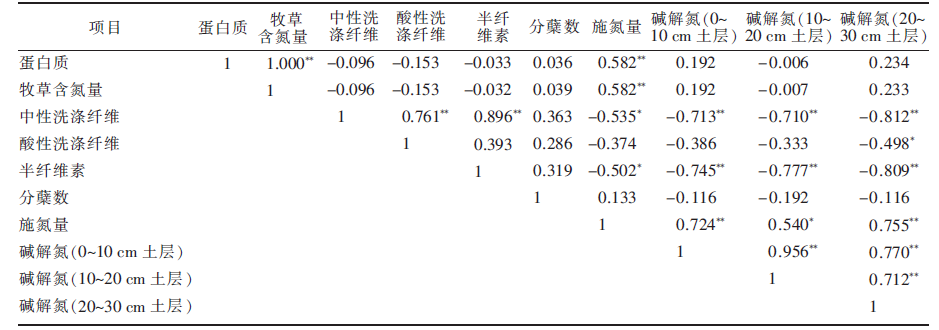| [1] |
杨建, 雷雄, 陈煜坤, 等. 多花黑麦草与饲用燕麦引进品种在成都平原的生产性能评价[J]. 草业科学, 2020, 37(6):1124-1132.
|
| [2] |
MARTINEZ M F, ARELOVICH H M, WEHRHAHNE L N. Grain yield, nutrient content and lipid profile of oat genotypes grown in a semiarid environment[J]. Field Crops Research, 2010, 116(1/2):92-100.
doi: 10.1016/j.fcr.2009.11.018
|
| [3] |
柴继宽, 赵桂琴, 张丽睿, 等. 施氮及间作对燕麦干物质积累、分配和氮素吸收利用的影响[J]. 中国草地学报, 2023, 45(1):88-98.
|
| [4] |
付东青, 王彦超, 宋磊, 等. 施氮量和种植密度对石河子复播早熟饲用燕麦生产性能的影响[J]. 草地学报, 2021, 29(10):2364-2371.
doi: 10.11733/j.issn.1007-0435.2021.10.029
|
| [5] |
宋雨桐, 王建丽, 刘杰淋, 等. 施肥和种植密度对5个燕麦品种产量和品质的影响[J]. 中国草地学报, 2020, 42(6):149-156,164.
|
| [6] |
张玉霞, 王鑫, 张庆昕, 等. 施氮水平对沙地生境下不同饲用燕麦品种干物质积累及氮素吸收利用的影响[J]. 西北农林科技大学学报(自然科学版), 2022, 50(4):93-99,107.
|
| [7] |
韩文元, 赵宝平, 任鹏, 等. 内蒙古农牧交错区施氮量对燕麦饲草产量和饲用品质的影响[J]. 中国农学通报, 2015, 31(24):122-127.
doi: 10.11924/j.issn.1000-6850.casb15040192
|
| [8] |
段旺军, 杨铁钊, 戴亚, 等. 植物氮素营养与病害发生关系研究进展[J]. 西北植物学报, 2011, 31(10):2139-2146.
|
| [9] |
BASSO B, CAMMARANO D, FIORENTINO C, et al. Wheat yield response to spatially variable nitrogen fertilizer in Mediterranean environment[J]. European Journal of Agronomy, 2013, 51:65-70.
doi: 10.1016/j.eja.2013.06.007
|
| [10] |
马雪琴, 赵桂琴, 龚建军. 高寒牧区播期和施氮对不同燕麦品种氮素利用的作用[J]. 草业科学, 2008, 25(5):36-41.
|
| [11] |
VAN LAAR J M. Antibodies against citrullinated proteins: Which test is best?[J]. Nature Clinical Practice Rheumatology, 2006, 2(12):652-653.
doi: 10.1038/ncprheum0354
|
| [12] |
READ J J, REDDY K R, JENKINS J N. Yield and fiber quality of upland cotton as influenced by nitrogen and potassium nutrition[J]. European Journal of Agronomy, 2006, 24(3):282-290.
doi: 10.1016/j.eja.2005.10.004
|
| [13] |
ROHWEDER D A, BARNES R F, JORGENSEN N. Proposed hay grading standards based on laboratory analyses for evaluating quality[J]. Journal of Animal Science, 1978, 47(3):747-759.
doi: 10.2527/jas1978.473747x
|
| [14] |
MASSEY J, ANTONANGELO J, ZHANG H L. Nitrogen fertilization and harvest timing affect switchgrass quality[J]. Resources, 2020, 9(6):61.
doi: 10.3390/resources9060061
|
| [15] |
金海. 对当前发展内蒙古畜牧业的几点思考[J]. 畜牧与饲料科学, 2010, 31(S1):109-112.
|
| [16] |
田永雷, 白春利, 慕宗杰, 等. 不同氮肥施用量对阴山北麓饲用燕麦抗氧化酶活性的影响[J]. 畜牧与饲料科学, 2022, 43(2):84-89.
|
| [17] |
王晓岚, 卡丽毕努尔, 杨文念. 土壤碱解氮测定方法比较[J]. 北京师范大学学报(自然科学版), 2010, 46(1):76-78.
|
| [18] |
BREMER D J, HAM J M, OWENSBY C E, et al. Responses of soil respiration to clipping and grazing in a tallgrass prairie[J]. Journal of Environmental Quality, 1998, 27(6):1539-1548.
|
| [19] |
李泽民, 张晨, 张桂国, 等. 应用聚酯网袋测定饲料中中性洗涤纤维和酸性洗涤纤维含量的可行性研究[J]. 动物营养学报, 2020, 32(12):5967-5975.
doi: 10.3969/j.issn.1006-267x.2020.12.051
|
| [20] |
DODOR D, TABATABAI M. Alkaline hydrolyzable organic nitrogen as an index of nitrogen mineralization in soils: Relationship with activities of arylamidase and amidohydrolases[J]. Communications in Soil Science and Plant Analysis, 2020, 51(13):1757-1766.
doi: 10.1080/00103624.2020.1791162
|
| [21] |
刘学军, 赵紫娟, 巨晓棠, 等. 基施氮肥对冬小麦产量、氮肥利用率及氮平衡的影响[J]. 生态学报, 2002, 22(7):1122-1128.
|
| [22] |
张永亮, 张浩. 行距与氮肥对虉草分蘖和产量的影响[J]. 中国草地学报, 2013, 35(2):43-47.
|
| [23] |
LIU Z L, MENG J R, SUN Z F, et al. Zinc application after low temperature stress promoted rice tillers recovery: Aspects of nutrient absorption and plant hormone regulation[J]. Plant Science, 2022, 314:111104.
doi: 10.1016/j.plantsci.2021.111104
|
| [24] |
LIU Y, GU D D, DING Y F, et al. The relationship between nitrogen, auxin and cytokinin in the growth regulation of rice (Oryza sativa L.) tiller buds[J]. Australian Journal of Crop Science, 2011, 5:1019-1026.
|
| [25] |
赵浩波, 任卫波, 于秀敏, 等. 不同氮素水平对羊草形态及生理指标的影响[J]. 中国草地学报, 2020, 42(3):15-20.
|
| [26] |
向芬, 李维, 刘红艳, 等. 氮素水平对茶树叶片氮代谢关键酶活性及非结构性碳水化合物的影响[J]. 生态学报, 2019, 39(24):9052-9057.
|
| [27] |
徐向英, 王岸娜, 林伟静, 等. 不同燕麦品种的蛋白质营养品质评价[J]. 麦类作物学报, 2012, 32(2):356-360.
|
| [28] |
肖相芬, 周川姣, 周顺利, 等. 燕麦氮吸收利用特性与适宜施氮量的定位研究[J]. 中国农业科学, 2011, 44(22):4618-4626.
doi: 10.3864/j.issn.0578-1752.2011.22.008
|
| [29] |
ASTHIR B, JAIN D, KAUR B, et al. Effect of nitrogen on starch and protein content in grain influence of nitrogen doses on grain starch and protein accumulation in diversified wheat genotypes[J]. Journal of Environmental Biology, 2017, 38(3):427-433.
doi: 10.22438/jeb/
|
| [30] |
柳嘉佳, 刘济明, 王军才, 等. 不同氮素水平对米槁幼苗生长和生理特性的影响[J]. 南方农业学报, 2017, 48(10):1863-1869.
|
| [31] |
WANG Y H, FENG Y, XU N Y, et al. Response of the enzymes to nitrogen applications in cotton fiber (Gossypium hirsutum L.) and their relationships with fiber strength[J]. Science in China Life Sciences, 2009, 52(11):1065-1072.
|
| [32] |
DELEVATTI L M, CARDOSO A S, BARBERO R P, et al. Effect of nitrogen application rate on yield, forage quality, and animal performance in a tropical pasture[J]. Scientific Reports, 2019, 9(1):7596.
doi: 10.1038/s41598-019-44138-x
pmid: 31110320
|
| [33] |
PEYRAUD J L, ASTIGARRAGA L. Review of the effect of nitrogen fertilization on the chemical composition, intake, digestion and nutritive value of fresh herbage: Consequences on animal nutrition and N balance[J]. Animal Feed Science and Technology, 1998, 72(3/4):235-259.
doi: 10.1016/S0377-8401(97)00191-0
|
| [34] |
赵京东, 宋彦涛, 徐鑫磊, 等. 施氮和刈割对辽西北退化草地牧草产量和品质的影响[J]. 草业学报, 2021, 30(8):36-48.
doi: 10.11686/cyxb2020292
|
| [35] |
庞鑫, 吕凤, 汪晓娟, 等. 饲喂不同中性洗涤纤维水平开食料对7-56日龄羔羊生长性能和养分表观消化率的影响[J]. 动物营养学报, 2021, 33(7):4175-4182.
doi: 10.3969/j.issn.1006-267x.2021.07.058
|












